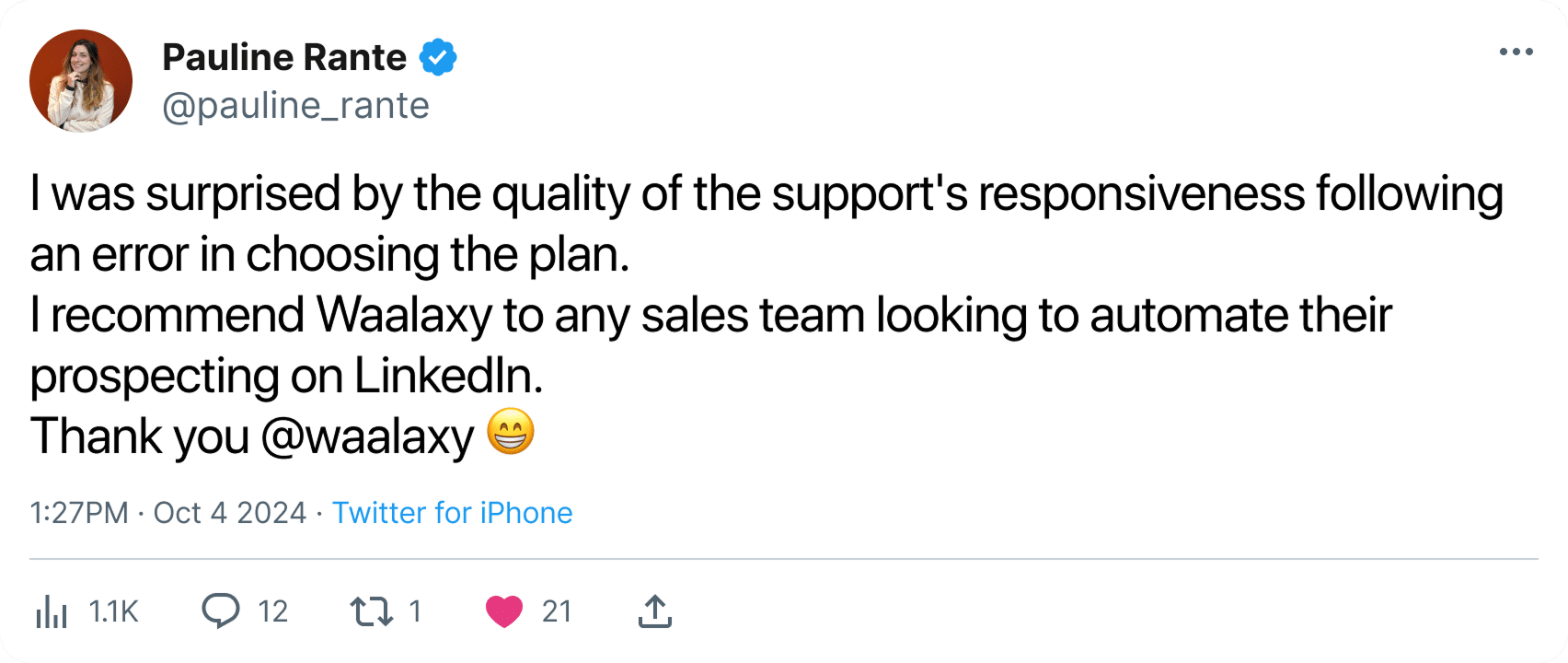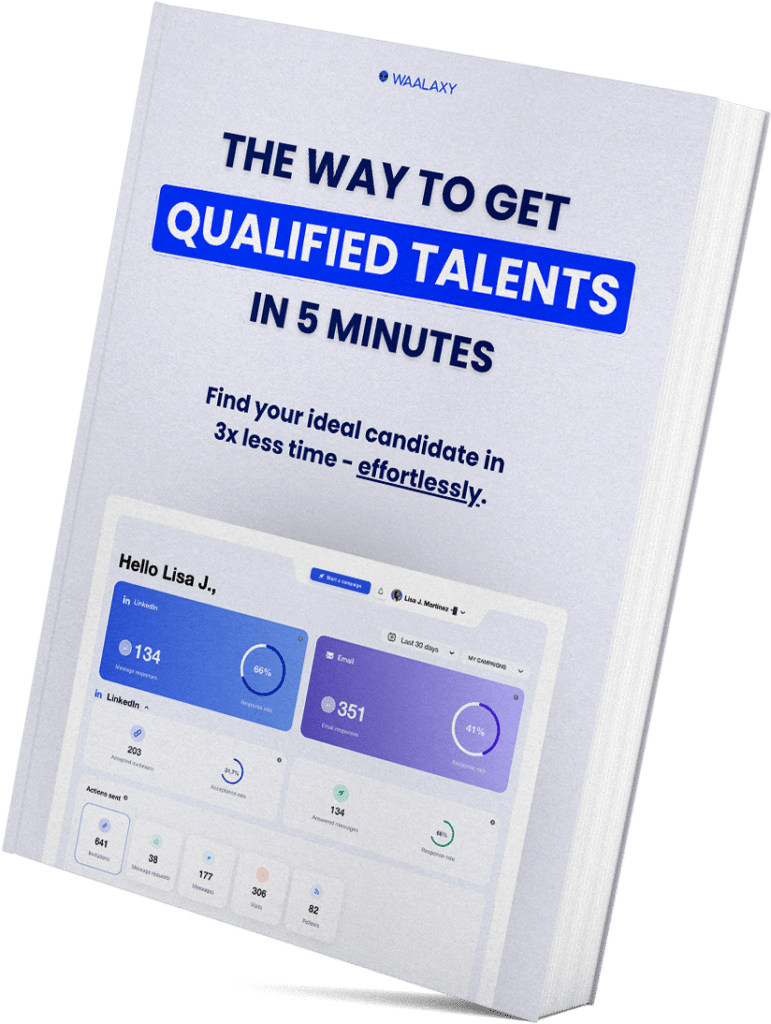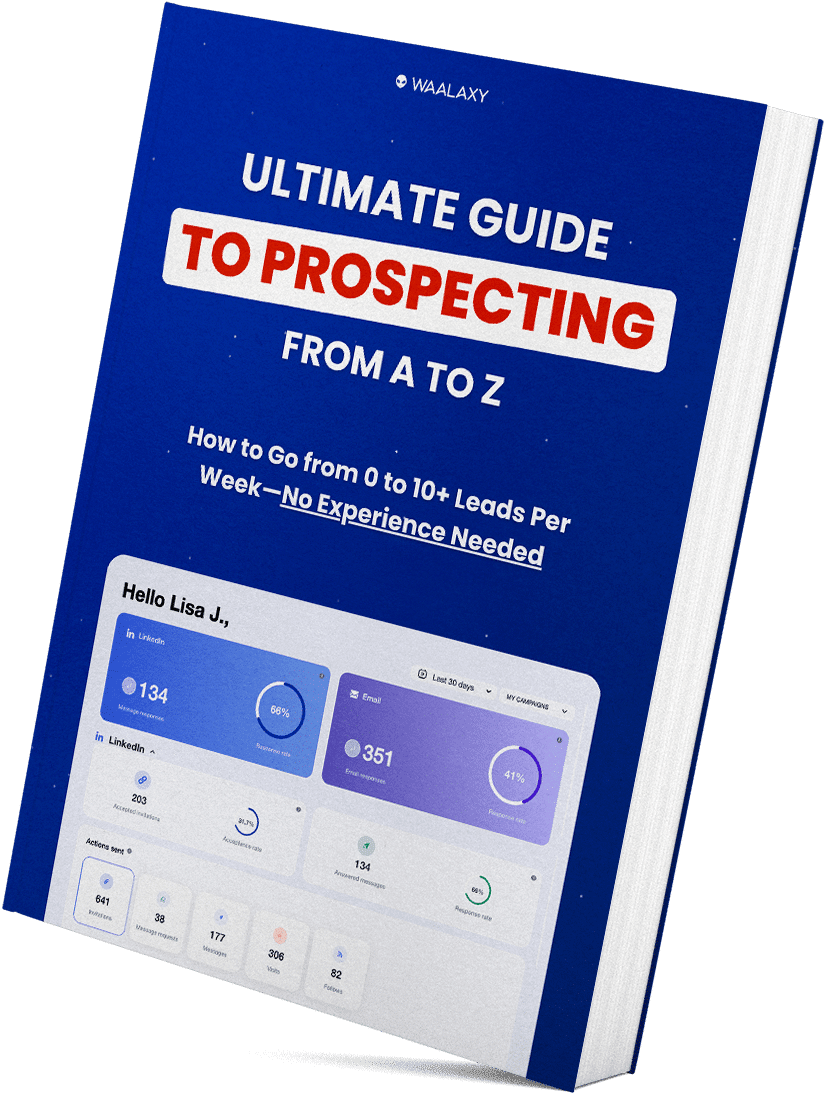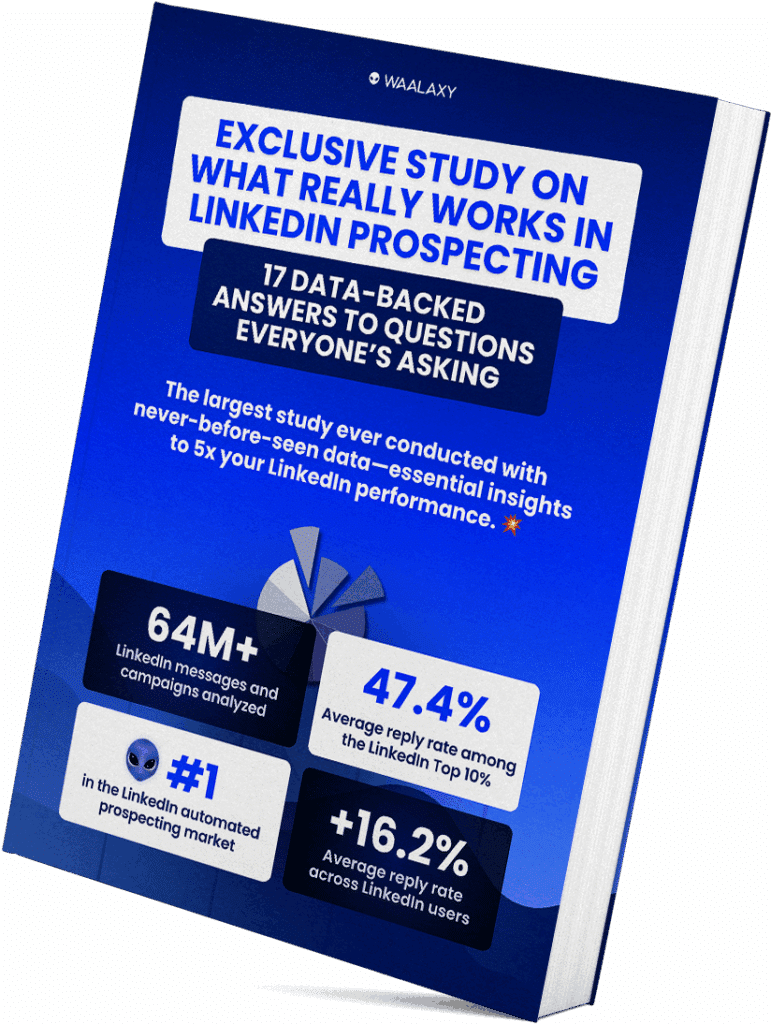5 Whys method is an ultra-easy-to-use but highly effective analysis tool for identifying the bottlenecks that are holding back your prospecting and making a rapid diagnosis without mobilizing heavy resources. 🤩
For example: Why aren’t your leads responding? Bad timing, poorly formulated message, wrong target? Perhaps. 🤷🏻♀️
But all too often, we treat the symptoms but don’t reach the root cause failof the problem. What if the real cause lies elsewhere?
Precisely, the 5 Whys method helps you ask the right questions to go beyond the symptoms, identify root causes of a problem, and thus build sustainable actions to be transformed into real performance levers, rather than simply applying patches. 🌱
➡️ Program:
- 5 Why approach: a simple tool for diagnosing and correcting your friction points in prospecting.
- What are the 5 Whys? Principle, origin, benefits, how does it works and model to follow.
- How to use it? The 8-step of 5 Whys process.
- How to apply the method to your prospecting?
- 5 examples of prospecting problems to be solved using the 5 Whys method: why a lead doesn’t respond, why a KPI doesn’t convert, optimizing the conversion tunnel, writing a powerful message, etc…
- Tools and tips for applying the method.
We’re off! 🔥
What is the 5 Whys method? Root cause analysis (RCA)
🔄 The 5 Whys method involves solving problems by repeatedly asking the question « Why? » —usually 5 times (and sometimes 6)—to:
- Relativize the immediate impact of a problem and focus on what really matters in the long term.
- Gradually eliminate superficial assumptions, to avoid treating only the symptoms of the problem. 🤒
- Uncover the underlying causes of the problem, but essential to sustainably correcting a problem and getting to the root cause analysis of a malfunction. 💡
- Develop sustainable solutions or action plans to solve problems around a common vision / shared observation (where the team members has identified what is really blocking).
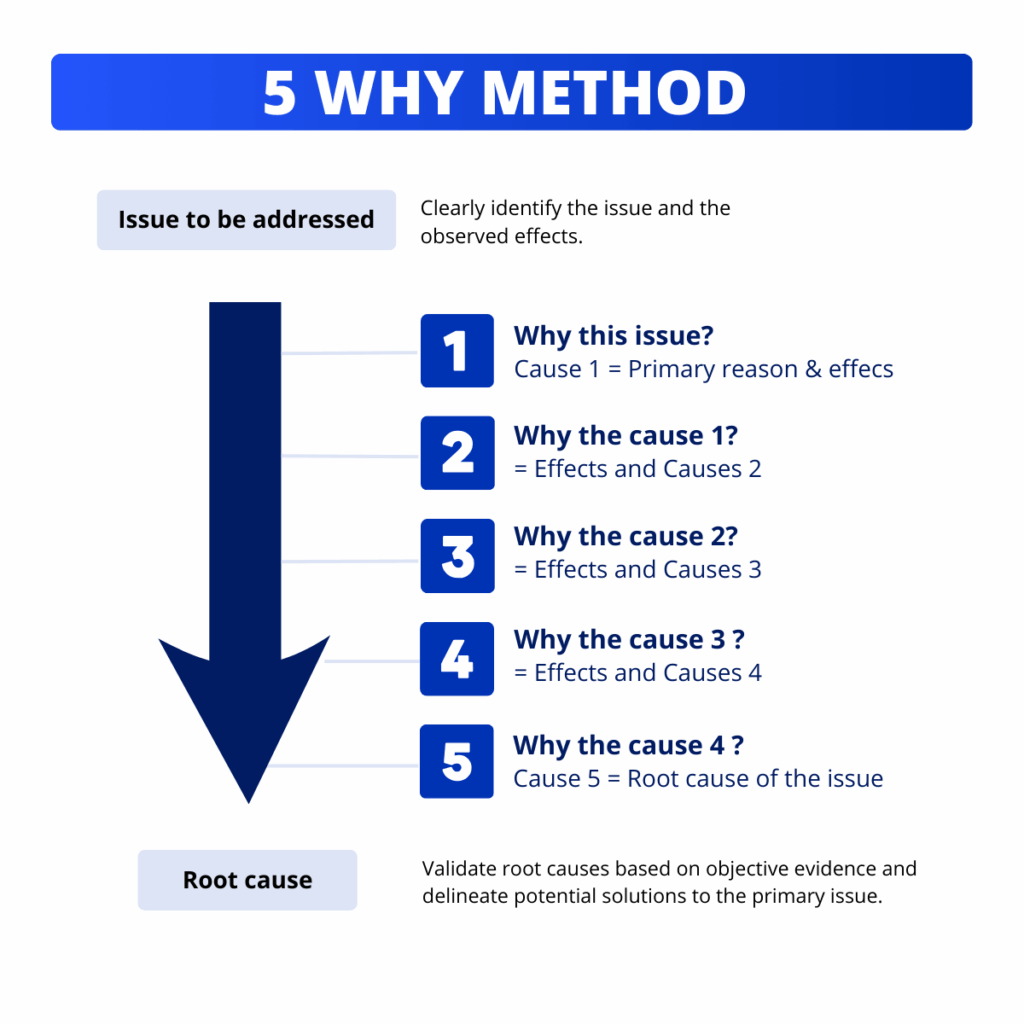
The 5 why approach is a resolution method that was developed by Taiichi Ohno, an engineer at Toyota Industries 🚙, as part of the Lean manufacturing production system (agile project management). It was originally developed by Sakichi Toyoda, founder of Toyota industries.
At the time, it was used to improve industrial processes by diagnosing the quality of work and identifying the real sticking points within the manufacturing chain.
Since then, it has spread widely as a simple yet powerful problem-solving technique and continuous improvement process, including in other fields.
Its main advantage? 🌟 No need for complex tools or statistical analysis, just a healthy dose of curiosity, rigor, and strategic thinking.
The result? ✅ A rapid ROI in terms of both operational efficiency and decision-making quality.
How to use the 5 Whys method? Tips and process to follow
To apply the 5 Whys method effectively, we recommend you work as a team and follow a method.
1. Start by organizing a collaborative meeting with the stakeholders concerned by the problem. 🤝 The aim is to identify the main sticking point together, formulating it clearly and precisely.
2. Once this problem has been defined, the group successively asks the question « Why? » until the root cause of the problem is identified. 🚩 Once identified, it becomes easier to propose relevant corrective actions, involve the right people and draw up a concrete action plan.
3. Finally, it’s essential to formalize the results, monitor progress over time and, if necessary, use statistical tools or project management software to sustain improvements / optimize your project management. ⚙️
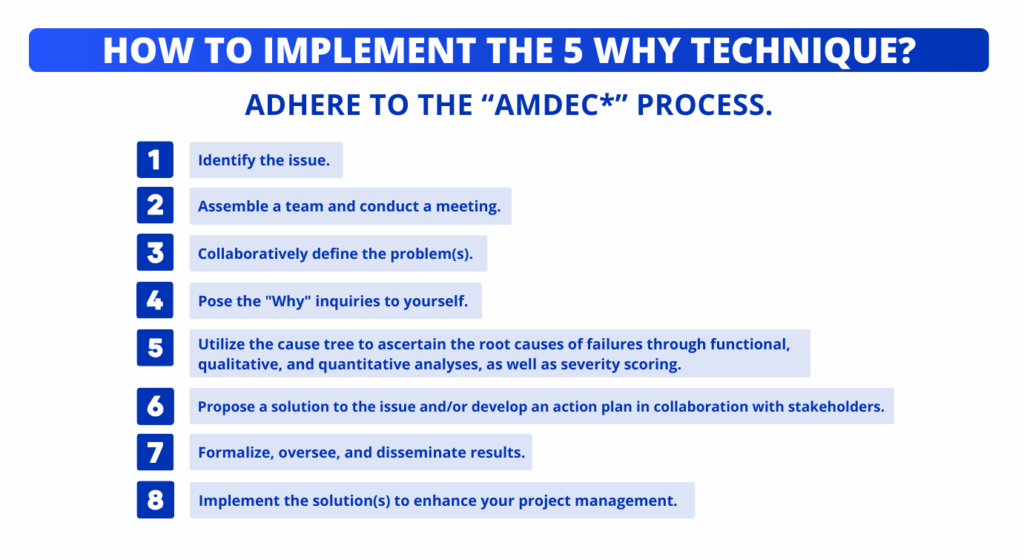
To structure this thinking, you can rely on a cause tree or couple the approach with a method like FMEA (Failure Modes and Effects Analysis), which allows you to prioritize risks according to their impact.
How to conduct a 5 Whys method to solve a prospecting issue? 5 Whys template
Although born in industry, the 5 whys method finds its perfect place in professions such as: management, product analysis, customer service, marketing… and of course sales prospecting. 🎯
Let’s take a quick, concrete 5 Why example:
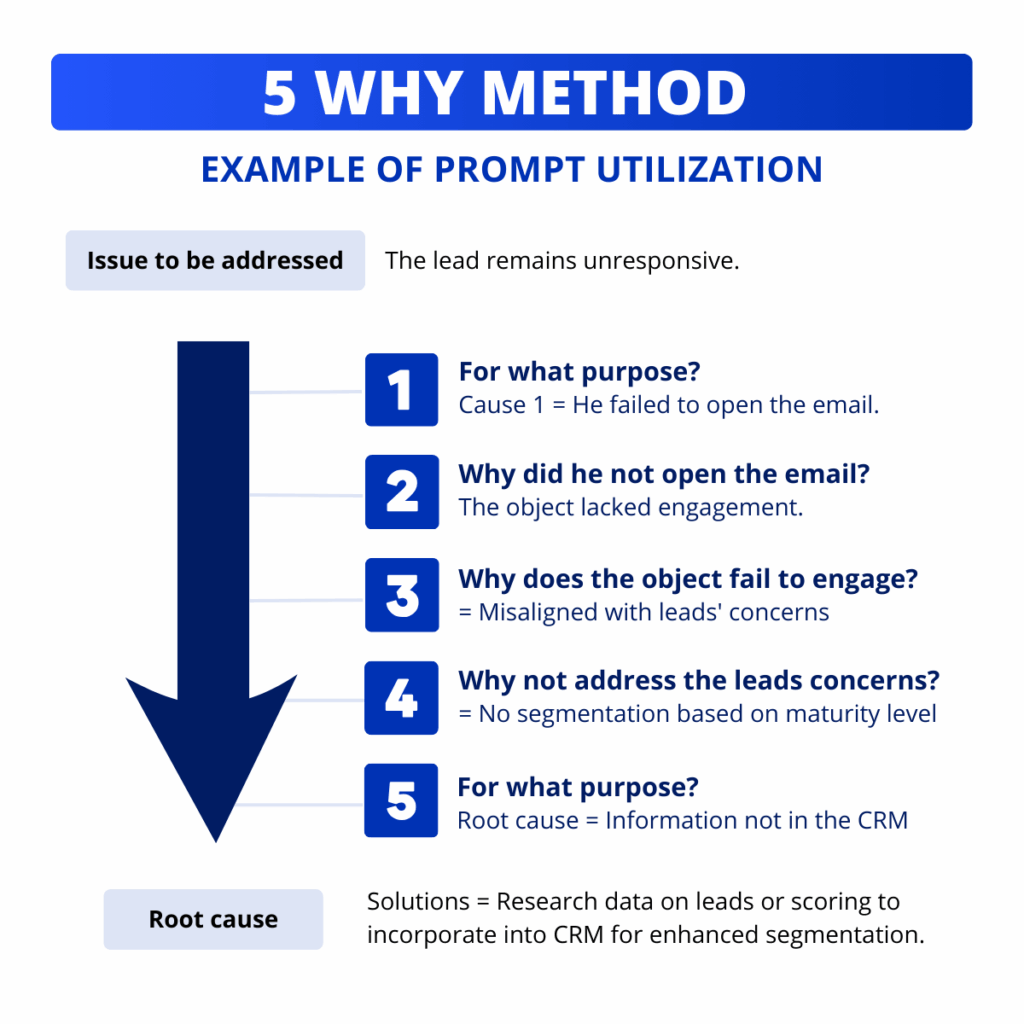
| 🔎 Initial problem identified (Must be as precise as possible) | A lead is not responding to your email campaign. |
| Why has this happened? | He didn’t open the e-mail. (Becomes the new problem to be solved). |
| Why did this happen? | The subject line was not engaging (becomes the new problem to be solved, we ask why again and so on until the root cause is found). |
| Why not? | It didn’t reflect his current concerns. |
| Why not? | The lead was not segmented according to its level of maturity. |
| Why not? | CRM does not contain this information. = Root cause of a problem |
When a prospect doesn’t respond, the classic reflex is to tell yourself “we’ll just have to follow up”… again and again. But this is a superficial solution that’s often based on assumptions. 🤷🏻♀️
And there, in a matter of minutes, the 5 Whys method took things a step further by identifying the real reason for the silence. 🤩
In five simple questions, we move from a superficial observation (“unresponsive lead”) to a structural flaw in data management (the real root cause).
👉🏼 The real problem wasn’t a lack of follow-ups but inaccurate customer segmentation and poorly targeted messages due to incomplete CRM data.
Tip: To enrich the analysis, exploit behavioral data (clicks, opens, views on LinkedIn) or automatic responses (if necessary via tracking). These weak signals are often valuable clues for asking the right questions.
There, now that you know how to apply the 5 Whys method in concrete terms, here are some more concrete examples to better visualize its effectiveness on prospecting topics that everyone encounters. 👀
How to use 5 whys analysis in prospecting ? 5 examples
The following examples of RCA analysis are fictitious but can be applied to real-life situations (not exhaustive, of course, as there are hundreds of possible situations).
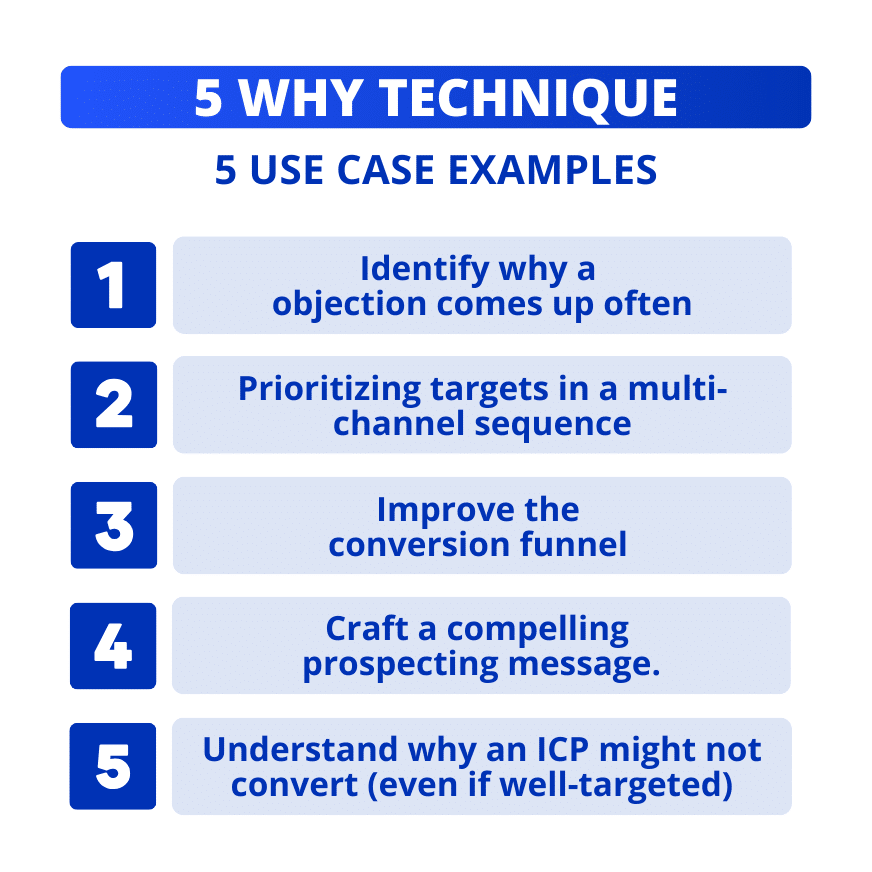
They demonstrate that the 5 Whys method is truly effective in avoiding 95% of false diagnoses, and in readjusting the strategy in depth in almost all cases. 💯
Example #1: Identifying why an objection comes up often
When the same objection comes up frequently in your sales exchanges – “It’s too expensive”, “It’s not the right time”, “We already have a tool”, etc. 😩 – it’s tempting to try and handle with objections with a ready-made answer.
But behind every recurring objection often lies a deeper problem. The 5 Whys method allows us to go beyond the wording to understand the real blockage.
Take the objection “It’s not a priority for us right now” 🤪 :
| Why isn’t it a priority? | Their focus is on organic growth (or growth marketing). |
| Why do they focus on organic growth? | Their budget is frozen for external tools. |
| Why is the budget frozen? | They didn’t see the immediate ROI of our solution. |
| Why didn’t they see this ROI? | The example presented didn’t fit their context. |
| Why was the example poorly targeted? | The sequence was not adapted to their business sector. |
➡️ Result: the objection is not a rejection, but a lack of research and personalization of the sequence upstream.
Using the 5 Whys method enables you to adapt your sales pitches, adjust your use cases, and avoid repeating the same mistakes with each follow-up.
Examples #2: Prioritizing targets in a multi-channel sequence
In multi-channel prospecting (e-mail, LinkedIn, calls, etc.), it’s common to launch a broad sequence… but get very uneven results depending on the leads. 😬
Rather than increasing volume or multiplying follow-ups, the 5 Whys method helps you understand why certain profiles respond better than others.
So you can prioritize your efforts more effectively. 💪🏼
For example, the problem statement identified is: 2x more responses obtained via LinkedIn than via e-mail.
| Why does LinkedIn work better? | Higher response rates. |
| Why do these leads respond better on LinkedIn? | They are more active on this channel. |
| Why are they more active? | These are marketing profiles, with a strong presence on LinkedIn. |
| Why are these profiles also targeted by e-mail? | Initial targeting didn’t differentiate between channels. |
| Why was this targeting uniform? | No sorting was done based on buyer personas‘ habits. |
➡️ Result: to maximize your chances, you need to adapt channels according to your targets’ behaviors, not according to a uniform logic.
The 5 Whys method lets you know that you need to optimize your sequence by priority, not by volume.
The 5 Whys method allows you to isolate the real sticking point without calling everything into question. Avoid changing the whole sequence when just one element is at fault, sometimes all it takes is a small, well-targeted adjustment to reverse the trend.
Example #3: Optimizing the conversion tunnel
The 5 Whys method is also an excellent tool for analyzing friction points in the conversion tunnel. 💥
From initial contact to closing, every stage can be scrutinized to understand where prospects drop out… and why.
Let’s take a common case 🔍: the prospect cancels his appointment at the last minute (we could also have chosen another common situation like “the prospect ghosts after the call” 👻).
| Why did the prospect cancel? | He no longer saw the point of the appointment. |
| Why didn’t he see the point? | He thought it would be a standard product demo. |
| Why did he think that? | The confirmation e-mail was too generic. |
| Why was the e-mail generic? | It’s a non-customized template. |
| Why is this template used by default? | No process is in place to adapt it to the lead’s profile. |
➡️ Result: the problem isn’t the promise, the product or the timing, but a lack of contextualization in the pre-RDV phase. It’s up to you to choose the best solution to solve the problem on your own scale.
By asking the right questions at each stage of the tunnel (no-show, frozen deal, loss of interest), you move from a defensive posture (“that’s the way it is”) to a proactive approach to continuous improvement, based on real, actionable causes. ✅
Example #4: Write a powerful prospecting message
A good prospecting message isn’t just a nice turn of phrase or a good call-to-action.
It’s a message that taps into the heart of the prospect’s real problem and pain. 💘 Thanks to the 5 Whys method, you can dig beyond the obvious to turn a simple benefit into an ultra-contextualized value proposition.
Let’s take an example: you’re selling a LinkedIn automation tool.
| Why does my prospect need to automate? | He wants to save time. |
| Why does he want to save time? | He spends too many hours prospecting manually. |
| Why is prospecting so time-consuming? | He has no structured sequences. |
| Why doesn’t he have sequences? | He’s never had the time to build them. |
| Why this lack of time? | He also manages marketing, alone, in a small team. |
➡️ Result: you go from a message like “Save time with automation” to one like
“Automate your prospecting to spend 3x less time on marketing management”.
A more human, more precise and far more effective message. 🔥
Example #5: Analyzing why a KPI doesn’t convert (even though it’s well-targeted).
You’ve targeted your Ideal Customer Profile (ICP) perfectly… and yet you’re seeing a disappointing conversion rate. 😓
Here, the 5 Whys method enables you to investigate this discrepancy between theoretical targeting and reality on the ground in more detail, and identify friction in the qualification or sales phase. 👀
| Why doesn’t the KPI convert? | It doesn’t move into the closing phase. |
| Why doesn’t it go to closing? | It doesn’t perceive urgency. |
| Why is there no sense of urgency? | He doesn’t feel concerned by the promise. |
| Why isn’t he concerned? | He’s not the final decision-maker. |
| Why do we contact this profile? | He fits our buyer persona, but not the right role in the company. |
➡️ Result: you haven’t contacted the right person. You may be targeting the right type of company, but not the right person.
To ask the right questions, you can adopt another very effective approach: reverse the process to build a prospecting message that anticipates the obstacles (which have been identified with the 5 Whys method).
🧠 Example of questions to ask yourself (there are others for understanding weak or superficial signals of interest):
- Why does this prospect have this problem?
- Why is this problem a priority today?
- Why hasn’t he found a solution yet?
- Why is my solution credible for him?
- Why should he answer me now?
A powerful way to reconnect perceived promise and felt value, while refining qualification and discourse.
In short, this type of analysis not only enables us to better understand our failures but above all to implement sustainable actions: CRM enrichment, refined segmentation, targeted copywriting…
Tools to help you apply the 5 Whys method
Once you’ve understood the 5 Whys, you need to apply them smoothly and consistently to your prospecting processes.
Even though it’s a really simple method, there’s nothing like a checklist or data integrated directly into a CRM, Notion or Google Sheet. ⚙️
5-question checklist for each stage of prospecting
💡 At every stage of the cycle—whether making contact, qualifying, or converting—you can use these 5 questions to identify what’s really blocking:
- What is the observed problem (symptom)?
- Why does it occur at this stage?
- Why is this cause recurring?
- Why hasn’t it been corrected yet?
- Why should it be addressed now?
This approach helps you clarify your priorities, avoid false assumptions and focus your efforts on high-impact actions. 💥 It can be used solo but is particularly powerful in a team debriefing or weekly update.
Integration into organization or prospecting tools
For the 5 Whys method to become a structuring reflex in your prospecting, it’s essential to integrate it directly into your day-to-day tools.
📊 A simple table in Google Sheets or Notion is all you need to create an analysis grid by funnel stage, sequence, or persona to apply the method and visualize recurring root cause.
By centralizing your thoughts, you facilitate exchanges with your team, capitalize on what you’ve learned… and save precious time with each iteration.
⚙️ You can also integrate this approach into your CRM by creating a personalized “5 Why Analysis” field on opportunities or leads closed without follow-up. This will enable you to trace the real reasons for non-conversion and feed into your future marketing and sales actions.
👽 If you use a solution like Waalaxy to automate your multi-channel prospecting, you can segment your leads according to the causes identified (with tags, e.g. wrong target, frequent objection, unsuitable timing) and adjust your sequences accordingly.
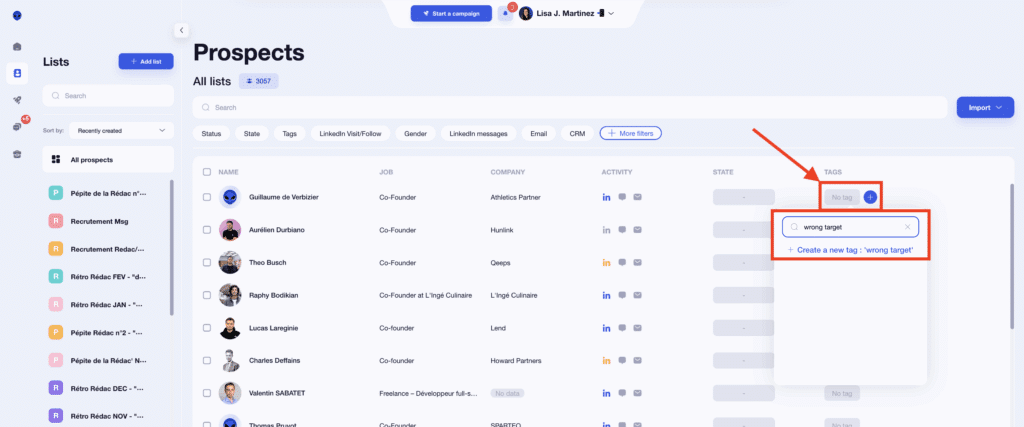
It’s a real lever for continuous optimization at the crossroads of automation, customer feedback, and sales strategy.
Conclusion—When to use 5 Whys method for problem-solving, and when not to?
In short, the 5 Whys is a simple but highly effective strategic analysis tool, helping you to sort out, understand, and adjust.
All you need to do is ask the right questions, in the right order. 👌
By asking about the pattern (targeting, timing, channel, wording), you can isolate the variable really responsible and act surgically to transform a symptom into lasting action.
And, refine your prospecting more finely and effectively, without calling into question your entire prospecting technique or strategy. 🤩
It’s ideally applied when a concrete problem arises in the field and helps identify the root cause, even when there are several factors at play.
Please note that this method is not suitable for complex problems or decisions based solely on quantitative data analysis. It comes after observation, not before.
Test the 5 Whys method today on your next sequence—you may well change your approach profoundly: 🪄
- Avoid Assumptions and Surface-Level Solutions.
- Close More Deals with Deeper Customer Understanding (uncover customer needs, motivations and pain points Identified).
- Continuously Improve Your Sales Strategy.
Frequently asked questions (FAQ) about 5 Whys methodology
🏁 To conclude, here are the answers to the most frequently asked questions on the subject “5 whys technique”. 👇🏼
How to ask the right questions in B2B prospecting?
In B2B prospecting, “asking the right questions” means digging deeper than the expressed need.
The 5 Whys method helps you structure this questioning. 🤔
- Start by identifying a symptom: a low response rate, an ignored message, a frozen deal…
- Then question each potential causes of a problem with a “Why?” until you reach a usable level of analysis.
- Give preference to open-ended, neutral questions, focused on the prospect’s context.
- The aim is not to judge but to understand in depth.
You can also use this method in the call phase, as these questions reinforce the salesperson’s credibility and the relevance of the message.
What’s the difference between the 5 Whys, FMEA and the Ishikawa diagram?
🤔 The 5 Whys start from an identified problem and aim to linearly find a single root cause. It’s a fast, targeted investigative tool.
complex
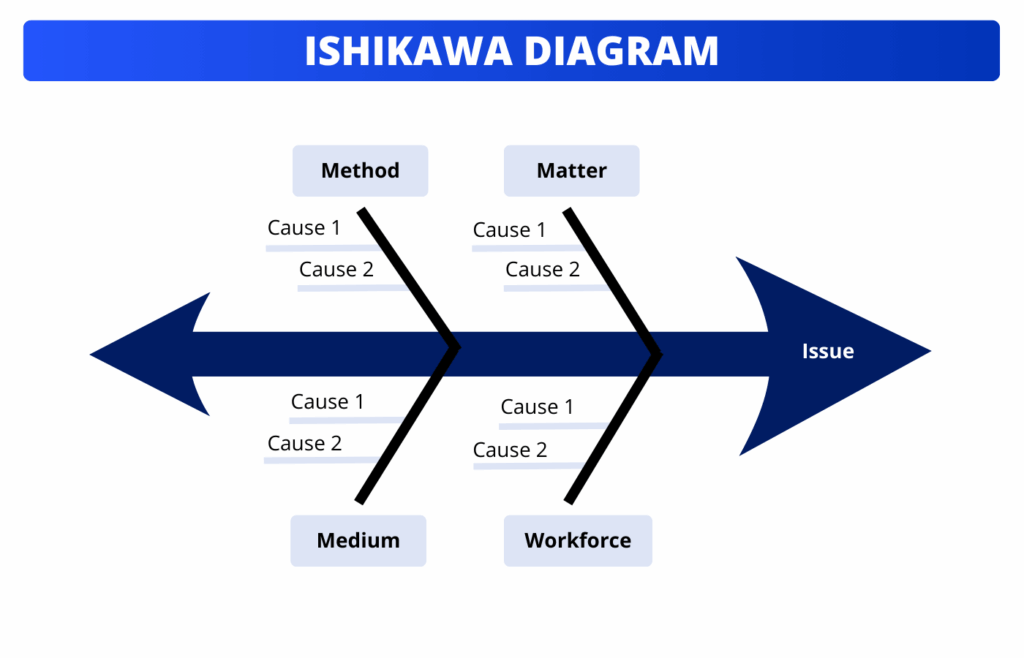
💣 FMEA is a method for analyzing, managing and prioritizing risks. The multi-step process assesses potential failures and their severity, frequency, and detection.
These tools are complementary, depending on the complexity of the problem.
Can the 5 Whys be used on LinkedIn?
Absolutely. ✅
The five Whys method can especially help you prospect by starting from your targets’ real pains or by intelligently bouncing off a publication or info shared by a lead.
Before you get started, ask yourself five questions around the problem: “Why would this prospect need my offer?”. This will enable you to move from a product-centric approach to a contextualized value proposition.
🦾 It’s a good way to get away from standard offers/campaigns and create added value.
There, now you know how to use the 5 whys method to boost your B2B prospecting—it’s up to you! 🕹️


